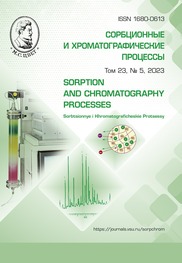Sorption of methylene orange on biocarbon sorbent, obtained by pyroly-sis of wastewater sludge
Abstract
Water pollution and deterioration of air and water quality is a rapidly growing problem directly related to the generation of waste water and the accumulation of significant amounts of wastewater sludge (WWS). One of the methods for recycling WWS is their pyrolytic processing into biochar adsorbents for purification from various pollutants. The type of adsorbent and its properties play a key role in the efficiency of the purification process, which explains the relevance of the search for alternative materials for water treatment processes.
The purpose of the study was to create a biocarbon sorbent during the pyrolysis of wastewater sludge and determine its sorption capacity for the methylene orange dye. To obtain samples of biocarbon sorbent, dried and crushed samples of wastewater sludge were exposed to a temperature of 500 °C for 1.5 hours in a vacuum chamber with a heating rate to a given temperature of 5°C/min. Elemental analysis of the resulting sorbent allowed to establish a decrease in the content of carbon, oxygen, and sulphur: for C by 2.50 at.%, for O by 9.91 at.%, for S by 0.4 at.%, relative to WWS.
Scanning electron microscopy confirmed a significant reduction in the particle size of biochar compared to the original WWS sample. In the initial WWS sample, after the sample preparation stage, the dispersion of particle sizes was 10-70 µm, and after pyrolysis of the sediment, the dispersion decreased to the range of 10-45 µm. The percentage of biochar yield was calculated, constituting 42% of the weight of the initial WWS and studies on the sorption of methylene orange were carried out.
The sorption capacity of biochar for the anionic dye methylene orange after 120 min of sorption was 4.9 mg/g, the degree of solution purification reached 82%. The kinetics of dye sorption was correctly described by a pseudo-second-order equation and indicated the polymolecular nature of sorption.
Downloads
References
Vekshin A.A., Rassoxina E.V., Dyagelev M.Yu., Isakov V.G. Szhiganie osadka kak bezotxodny`j sposob utilizacii osadka stochny`x vod. Privolzhskij nauchny`j zhurnal, 2023; 2: 100-107.
Shi Y. et al. Synergetic conditioning of sewage sludge via Fe2+/persulfate and skeleton builder: effect on sludge characteristics and dewaterability. Chemical Engineering Journal. 2015; 270: 572-581. https://doi.org/10.1016/j.cej.2015.01.122
Dichtl N., Rogge S., Bauerfeld K. Novel strategies in sewage sludge treatment. CLEAN-Soil, Air, Water. 2007; 35(5): 473-479.
Nascimento A.L. Chemical attributes of sewage sludges: Relationships to sources and treatments, and implications for sludge usage in agriculture. Journal of Cleaner Production. 2020; 258: 120746. https://doi.org/10.1016/j.jclepro.2020.120746
Schlich K. Hazard assessment of a silver nanoparticle in soil applied via sewage sludge. Environmental Sciences Europe. 2013; 25(1): 1-14. https://doi.org/10.1186/2190-4715-25-17
Lasaridi K.E. The evaluation of hazards to man and the environment during the composting of sewage sludge. Sustainability. 2018; 10(8): 2618. https://doi.org/10.3390/su10082618
Zaker A. Microwave-assisted pyrolysis of sewage sludge: A review. Fuel processing technology. 2019; 187: 84-104. https://doi.org/10.1016/j.fuproc.2018.12.011
Racek J. et al. Biochar-recovery material from pyrolysis of sewage sludge: a review. Waste and biomass valorization. 2020; 11: 3677-3709.
Lwin C.S. Application of soil amendments to contaminated soils for heavy metal immobilization and improved soil quality – A critical review. Soil science and plant nutrition. 2018; 64(2): 156-167. https://doi.org/10.1080/00380768.2018.1440938
Wang Y., Li H., Lin S. Advances in the Study of Heavy Metal Adsorption from Water and Soil by Modified Biochar. Water. 2022; 14(23): 3894.
Shaaban M. A concise review of biochar application to agricultural soils to improve soil conditions and fight pollution. Journal of environmental management. 2018; 228: 429-440. https://doi.org/10.1016/j.jenvman.2018.09.006
Zhang X. Effects of pyrolysis temperature on biochar’s characteristics and speciation and environmental risks of heavy metals in sewage sludge biochars. Environmental Technology & Innovation. 2022; 26: 102288.
Udayanga W.D.C. Fate and distribution of heavy metals during thermal processing of sewage sludge. Fuel. 2018; 226: 721-744.
Hu Y. Characterization into environmentally persistent free radicals formed in incineration fly ash and pyrolysis biochar of sewage sludge and biomass. Journal of Cleaner Production. 2022; 373: 133666.
Aobo Geng, Lijie Xu, Lu Gan, Changtong Mei, Linjie Wang, Xingyu Fang, Meirun Li, Mingzhu Pan, Shuguang Han, Juqing Cui Using wood flour waste to produce biochar as the support to enhance the visible-light photocatalytic performance of BiOBr for organic and inorganic contaminants removal. Chemosphere. 2020; 250: 1-7.
Yu G. In situ reforming of the volatile by char during sewage sludge pyrolysis. Energy & Fuels. 2016; 30(12): 10396-10403.
Schmidt, Hans Peter; Bucheli, Thomas; Kammann, Claudia; Glaser, Bruno; Abiven, Samuel; Leifeld, Jens (2016). European Biochar Certificate – Guidelines for a sustainable production of Biochar. Arbaz (CH): European Biochar Foundation (EBC). https://doi.org/10.13140/RG.2.1.4658.7043
Thomas S.C., Gale N. Biochar and forest restoration: a review and meta-analysis of tree growth responses. New Forests. 2015; 46(5-6): 931-946.
Rosas J.G. Assessment of sustainable biochar production for carbon abatement from vineyard residues. Journal of analytical and applied pyrolysis. 2015; 113: 239-247.
Hale S. E. et al. A synthesis of parameters related to the binding of neutral organic compounds to charcoal. Chemosphere. 2016; 144: 65-74. https://doi.org/10.1016/j.chemosphere.2015.08.047
Zhang X. Effects of pyrolysis temperature on biochar’s characteristics and speciation and environmental risks of heavy metals in sewage sludge biochars. Environmental Technology & Innovation. 2022; 26: 102288. https://doi.org/10.1016/j.eti.2022.102288
Uchimiya M. Sorption of deisopropylatrazine on broiler litter biochars. Journal of agricultural and food chemistry. 2010; 58(23): 12350-12356. https://doi.org/10.1021/jf102152q
Ahmad M. Effects of pyrolysis temperature on soybean stover-and peanut shell-derived biochar properties and TCE adsorption in water. Bioresource technology. 2012; 118: 536-544. https://doi.org/10.1016/j.biortech.2012.05.042
Shi Y.Y., Shan R., Yuan H.R. Effects and mechanisms of methyl orange removal from aqueous solutions by modified rice shell biochar. Huan Jing ke Xue= Huanjing Kexue. 2019; 40(6): 2783-2792. https://doi.org/10.13227/j.hjkx.201811227
Yin G. Novel Fe-Mn binary oxide-biochar as an adsorbent for removing Cd (II) from aqueous solutions. Chemical Engineering Journal. 2020; 389: 124465.







